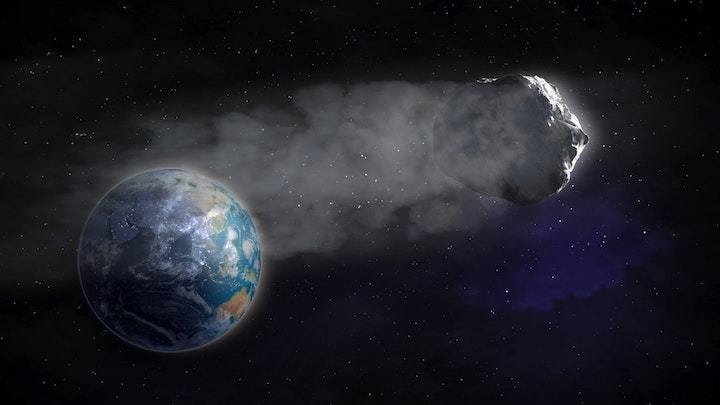13.01.2018
Researchers observe dramatic changes of speed in a comet’s spin, and find lessons for future NASA missions. Richard A Lovett reports.

A comet known as 41P/Tuttle-Giacobini-Kresák (or 41P, for short) has astounded planetary scientists by changing its rotation speed by a factor of more than two during a mere two months in 2017.
In early March, the comet, which came as close to the Earth as 21 million kilometres, was spinning about once every 20 hours. But by early May it had slowed to once every 46 to 60 hours, based on observations from a combination of ground and space-based telescopes.
It’s not the first time a comet has changed its spin. Comet 67P/Churyumov-Gerasimenko — the comet visited by the European Space Agency’s Rosetta mission — sped up by two minutes as it approached the sun, then slowed by 20 as it moved away. But no comet has ever before changed its spin by this much, this rapidly.
“The previous record went to 103P/Hartley 2, which slowed its rotation from 17 to 19 hours over 90 days,” says Dennis Bodewits of the University of Maryland, US, lead author of a new study in this week’s issue of Nature. “By contrast, 41P spun down by more than 10 times as much in just 60 days.”
The spindown, he added at a meeting of the American Astronomical Society in National Harbor, Maryland, would have been caused by jets of dust and ice crystals blown into space as ice deposits vaporised when the comet’s orbit carried it from the colder climes near Jupiter to the warmer ones closer to Earth.
Similar jets created the relatively small changes in the spin of comet P67, but on comet P41, they were far more effective at doing so. The difference, Bodewits says, is probably due to a combination of factors. These include the fact that the 1.4 kilometre diameter comet is small and relatively easy to shift, the alignment of the jets, and the fact that the jets are extremely active and therefore unusually powerful.
He and his colleagues have calculated that, by now, the rapid reduction of comet P41’s spin means that it may have slowed by another factor of two, with its rotation period longer than 100 hours — with even slower rates possible in the near future.
What that means, Bodewits says, is that “this comet cannot be in a stable state.” The slower it rotates, the easier it is for random forces to affect it, changing it from rotating to tumbling, in which it spins with no fixed rotational axis.
He compares it to what happens to a top when it starts to slow down and begins to wobble. “That is exactly what we think is going to happen to this comet,” he says.
Thus, the next time 41P approaches the sun, it may be spinning in an entirely different manner, exposing different parts of its surface to solar heating, creating a different pattern of jets.
But if the comet spent 2017 rapidly slowing down, what was it doing beforehand?
Projecting backward, Bodewits and colleagues calculate that at each prior close approach to the sun, P41 would have been spinning faster than at the one before. And with the comet’s orbit carrying it toward the sun every 5.4 years, it wouldn’t have been all that long ago since it might have been spinning extremely fast — faster than once every five hours.
That’s a speed at which it would have been on the verge of breaking up, because the centrifugal forces trying to tear it apart would have been stronger than the forces holding it together. At this time, landslides or giant cracks might have exposed buried ices that then produced the super-vigorous jets now slowing it down.
Prior to that critical point, its rotation might have been speeding up, rather than slowing. And prior to that — after a tumbling interlude — it might have been slowing down, as it is now.
“It may not be a coincidence that in 2001 it brightened by a factor of a thousand,” David Schleicher, an astronomer at Lowell Observatory who has been independently studying the comet’s motion said last year at a meeting of the AAS’s Division for Planetary Sciences in Provo, Utah. There were also two outbursts seen in 1973, about two months apart, he also noted.
“So was it also at break-up speed then?” he asked. If so, will it, 20 or 30 years from now again speed up enough to be on the verge of self-destruction?
In the long run, Bodewits says, the comet will probably settle down onto a stable rotation axis, “which is what we think most comets do.” But in the interim, he adds, “this is a rebel phase. We’re very interested to see if other comets do the same behavior or not.”
Humberto Campins, a planetary scientist at the University of Central Florida, Orlando, US, calls the new find “a remarkable observation,” noting that while scientists had previously known that comets could change their spins, “this was a dramatic demonstration.”
It’s also of importance to future cometary missions, particularly one called Comet Astrobiology Exploration Sample Return (CAESAR), which, if NASA approves it, will launch in 2024 or 25, arrive at Rosetta’s comet P67 in 2029, land, and return a sample to Earth in 2038.
“I am on the science team for CAESAR,” Campins says, “so this is pretty relevant. The insight about how quickly a comet can change rotation period is very relevant for us to plan our mission and consider contingencies.
“This raises a warning that we should not be completely reliant on the information that we got from Rosetta, because the comet can change.”
Quelle: COSMOS
